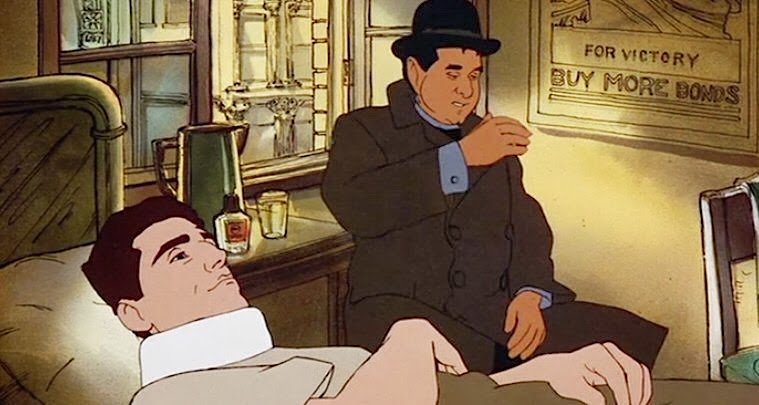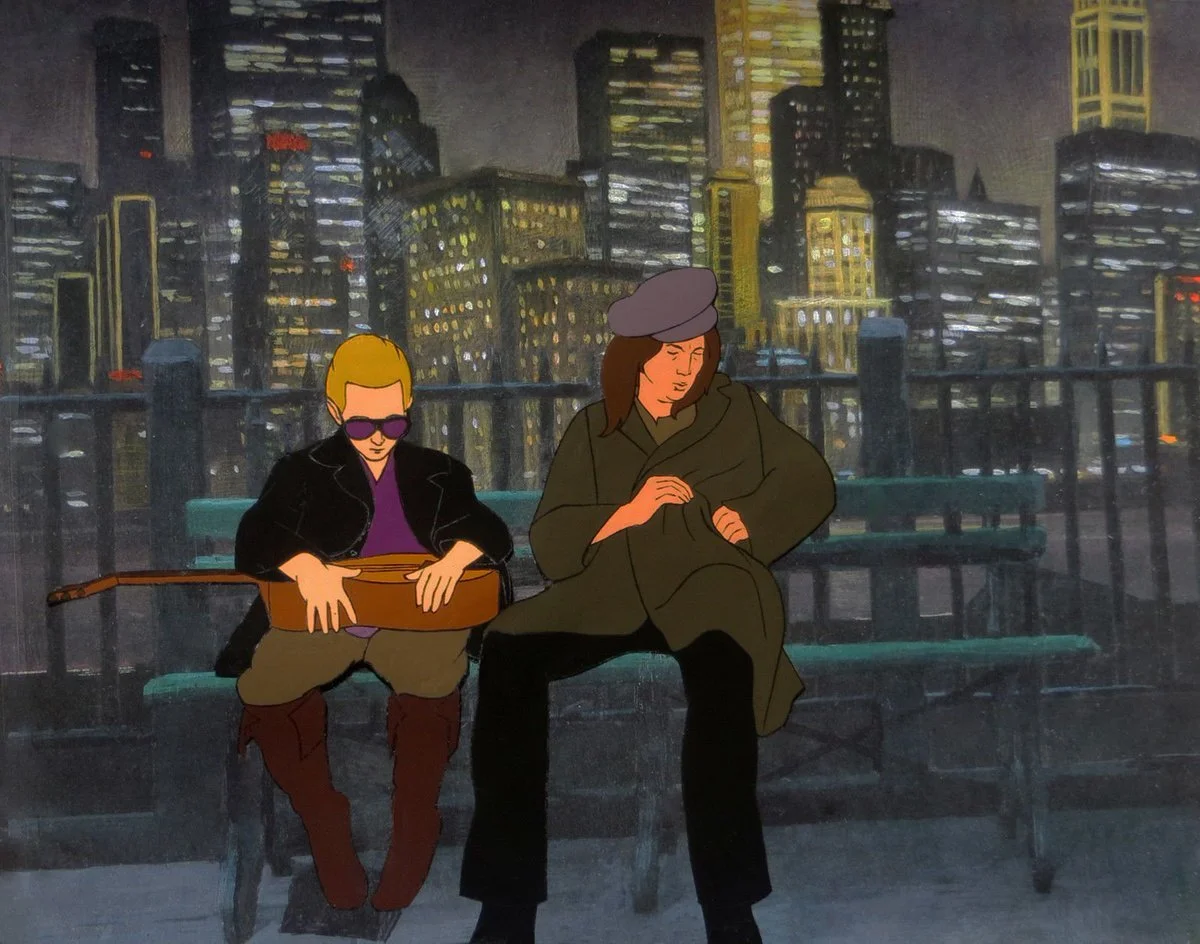American Pop
/TITLE American Pop
DIRECTOR Ralph Bakshi
STUDIO Bakshi Productions
YEAR 1981
COUNTRY USA
FILM REVIEW by Howard Leigh
American Pop, directed by Ralph Bakshi, is an interesting animated film that explores the tumultuous journey of four generations of a family immersed in the world of American popular music. Through its peculiar narrative structure, engaging character development, and thought-provoking themes, American Pop offers a captivating and immersive cinematic experience. In an era when animation was primarily associated with children, Bakshi shocked the audience's expectations by creating animated films that tackled mature themes and were unabashedly intended for adults. His first two films, Fritz the Cat (1972) and Heavy Traffic (1973), not only pushed boundaries but also became the first animated features to receive an X-rating.
Bakshi satirized racism in the controversial Coonskin (1975), and his adaptation of The Lord of the Rings (1978) preceded Peter Jackson's by a remarkable 23 years. Due to its flaws, Bakshi's Lord of the Rings failed to achieve the critical and commercial success he had hoped for. However, this disappointment spurred Bakshi to create a more personal film, and thus American Pop was born. Bakshi approached Dan Melnick, the president of Columbia Pictures, with his ambitious vision for American Pop. He aimed to create a film that would explore the relationship between music and visuals by curating an extensive soundtrack that would take on new meaning when juxtaposed with the film's imagery. Although the narrative of American Pop does not directly mirror Bakshi's personal experiences, its themes draw inspiration from the individuals he encountered in the neighborhood of Brownsville. To bring his vision to life, Bakshi assembled a talented crew, including esteemed character layout and design artist Louise Zingarelli, Vita, Barry E. Jackson, and Marcia Adams. Each member of the team infused their own unique artistic sensibilities into the fabric of the film, contributing to its distinctive visual style and storytelling.
“ Each protagonist represents a distinct era and musical genre, allowing the film to delve into the social and cultural dynamics of the time. From Zalmie’s dream of becoming a famous singer to Benny’s quest for success in the jazz scene, and subsequent generations grappling with their own ambitions and challenges, the characters’ aspirations and conflicts serve as a microcosm of the American Dream and its complexities. ”
American Pop weaves a captivating narrative that spans four generations of a Jewish immigrant family, highlighting the profound impact of music on their lives. True to Bakshi's signature style, this animated film confronts issues such as violence, sexuality, drug abuse, and poverty, proving that animation can be a medium for mature storytelling. We follow the torch as it passes from generation to generation, exploring the evolution of music genres such as swing, bebop, and rock 'n' roll, and the impact these changes have on the lives of the characters. The story begins in the 1890s, as Zalmie, a young boy, and his mother flee Russia after his father, a rabbi, is tragically killed by Cossacks. Settling in New York, Zalmie is raised by Louie, a vaudeville comedian, after his mother perishes in the infamous Triangle Shirtwaist Factory fire. Zalmie nurtures dreams of becoming a singer, but his aspirations are abruptly dashed when he sustains a throat injury during World War I. Determined to forge a new path, Zalmie marries Bella, a stripper, whom he manages professionally. However, his association with the mobster Nicky Palumbo ultimately leads to Bella's untimely demise and Zalmie's imprisonment. Benny enlists in the military, driven by a desire to atone for the transgressions committed by his father and father-in-law. Stationed in Europe, he yearns for his piano and serendipitously stumbles upon one in a dilapidated house amidst the ruins of Nazi Germany. Benny's fingers dance across the keys, playing a fragment of the timeless melody, "As Time Goes By." In an unexpected moment, a Nazi soldier enters the scene, interrupting Benny's reverie. Undeterred, Benny transitions seamlessly into "Lili Marleen." For a brief interlude, the language of music unites Benny and the German soldier, transcending the animosity of war. "Danke," he utters before callously ending Benny's life with a single gunshot. Tony, raised without the guiding presence of his father, embarks on a journey of self-discovery and rebellion, embracing the counterculture as a beatnik before eventually fleeing his childhood home.
Fate leads him to Kansas, where he engages in a fleeting encounter with a waitress, which sparks a passionate affair. Tony's musical talent blossoms as he becomes a songwriter for Frankie Hart, a compelling embodiment of the spirit of Janis Joplin. However, the allure of drugs casts a dark shadow over their lives, with both Tony and Frankie succumbing to the destructive grip of heroin. Tragically, Frankie's life is cut short by an overdose just moments before her scheduled opening act performance for Jimi Hendrix. Abandoned by Frankie's band, Tony spirals further into addiction, becoming entangled in the seedy underworld of drug dealing upon his arrival in New York. Accompanying him on this treacherous path is his son, Pete, a product of his liaison with the waitress. Pete, having experienced the heart-wrenching abandonment of his father, follows in his footsteps and rises to prominence as a successful drug dealer, catering to the demands of prominent rock bands. However, a transformative encounter with punk rock awakens a yearning within him for a more meaningful existence. Determined to alter his course, Pete boldly announces that he will only continue selling cocaine if granted the opportunity to record a demo. Miraculously, he is granted a band and a recording studio. In a remarkable and audacious act, Pete seizes the microphone and delivers a surprising choice of song: Bob Seger's "Night Moves" (arguably one of the few flaws in the otherwise exceptional tapestry of American Pop).
“Bakshi’s films encapsulate a distinct period in American animation and offer a distinctive artistic perspective that is worth exploring. Despite potential reservations, immersing oneself in Bakshi’s body of work can provide valuable insights and a deeper understanding of the evolution and variety within the realm of animated storytelling.”
One of the film's most striking aspects is its narrative structure. Rather than following a linear storyline, American Pop employs a mosaic-like approach, weaving together different time periods and characters' stories. This unconventional structure not only keeps the audience engaged but also emphasizes the cyclical nature of American music history. By intertwining the personal journeys of the characters with the broader cultural context, the film portrays music as a reflection of society and its constant evolution. Character development plays a vital role in American Pop, as the audience follows the lives and struggles of the family members across multiple generations. Each protagonist represents a distinct era and musical genre, allowing the film to delve into the social and cultural dynamics of the time. From Zalmie's dream of becoming a famous singer to Benny's quest for success in the jazz scene, and subsequent generations grappling with their own ambitions and challenges, the characters' aspirations and conflicts serve as a microcosm of the American Dream and its complexities. The film tackles several profound themes, ranging from the pursuit of artistic expression and the sacrifices required for success to the influence of external forces on individual lives. American Pop explores the interplay between personal aspirations and societal pressures, showcasing how the music industry and changing trends can shape and sometimes break the dreams of talented individuals. It raises questions about cultural appropriation, the impact of war and societal unrest on creative expression, and the enduring power of music as a means of connecting people across generations.
From a technical standpoint, the film combines traditional hand-drawn animation with other techniques, including rotoscoping, to create a visually compelling experience. Although techniques such as rotoscoping may appear rudimentary by contemporary standards, it effectively juxtaposes the euphoria of music with the grim realities of life, creating a visual dichotomy that underscores the film's thematic exploration. Notably, scenes of gang warfare draw inspiration from The Public Enemy, while footage of the Nicholas Brothers is employed in the energetic Sing Sing Sing With A Swing montage. Bakshi's use of vibrant colors and atmospheric lighting adds depth and emotion to the narrative, enhancing the impact of pivotal moments throughout the film. In conclusion, American Pop successfully intertwines the histories of American popular music and a family's journey across generations.
“The film tackles several profound themes, ranging from the pursuit of artistic expression and the sacrifices required for success to the influence of external forces on individual lives. American Pop explores the interplay between personal aspirations and societal pressures, showcasing how the music industry and changing trends can shape and sometimes break the dreams of talented individuals.”
The film is not without its flaws, some audiences may find the film aesthetic tedious, and punk enthusiasts may find the inclusion of "Night Moves" in a pivotal scene out of place within the overall genre aesthetic. Yet, missteps such as these should not detract from the film's merits and the impact of its narrative. Bakshi's film immerses the audience in a rich tapestry of music and human experience. It invites reflection on the transformative power of music, and the complexities of pursuing dreams. Moreover, American Pop features an interesting soundtrack that serves as the heartbeat of the story. The film seamlessly integrates popular songs from various eras, giving the audience an auditory journey through the evolution of American music. Each song becomes a narrative tool, representing the emotions and experiences of the characters at different stages in their lives. The music not only serves as a backdrop but also becomes a character in its own right, bridging gaps between generations and transcending barriers of time and space. While Ralph Bakshi's work may not cater to everyone's visual, moral, or thematic preferences, it is essential for animation enthusiasts to delve into his filmography. Bakshi's films encapsulate a distinct period in American animation and offer a distinctive artistic perspective that is worth exploring. Despite potential reservations, immersing oneself in Bakshi's body of work can provide valuable insights and a deeper understanding of the evolution and variety within the realm of animated storytelling.



































































